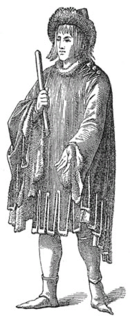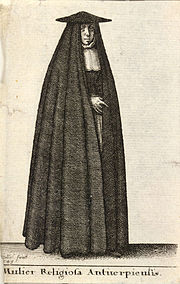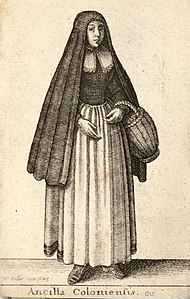Heuke

The Heuke (also: die or the Hoike , Low German Hoyke ) is a sleeveless, bell-shaped, almost calf-length cloak of the Middle Ages , which was closed over the shoulder for men, but was placed over the head for women.
The heuke is said to have its origin in North Africa, it became known in the 13th century in southern France. It was not used until after 1300 in northern Germany, where it was widely used as a men's coat in the middle classes in the first half of the 14th century. In the 15th to 17th centuries, the heuke was worn almost exclusively by wealthy citizens as a lady's coat. B. as part of the Bremen costume .
This type of coat is simply placed over the head and falls over the back to the floor. The heuke is closed by pulling the right side generously over the left front part at elbow height and fastening it there.

Heuken consisted, among other things, of thick wool, sometimes lined with fur . Actually without a collar, there were also versions with a collar for women. The way it was worn differed from one region to another. In Braunschweig there were Heuken so long that they were dragged along the ground (1409).
For women, the heuke was also stiffened on the head with a wire or attached to the head with a kind of round cap. A special variant was the Tipheuke or Tiphoike : Here the Heuke was held on the head with a round 'cap' reinforced with a piece of wood with a protruding point and a bobble (or tassel). This type of tipheuke was depicted more often by the famous copperplate engraver Wenceslaus Hollar in his 17th century costume designs.
As a rain protection, the Heuke was used in a modified form in some traditional costumes until the beginning of the 20th century.
- Different types of heuken (Wenceslaus Hollar, ca.1630-1670)
literature
- Ludmila Kybalová, Olga Herbenová, Milena Lamarová: The great image lexicon of fashion - from antiquity to the present , translated by Joachim Wachtel, Bertelsmann, 1967/1977
- Ingrid Loschek : Reclam's fashion and costume lexicon. 4th, revised and expanded edition. Philipp Reclam jun., Stuttgart 1999, ISBN 3-15-010448-3 .
Individual evidence
- ^ Els Oksaar : Middle High German. Texts, comments, linguistics, dictionary. Almquist & Wiksell, Stockholm et al. 1965, p. 259.
- ↑ Ludmila Kybalová, Olga Herbenová, Milena Lamarová: The great image lexicon of fashion - from antiquity to the present , translated by Joachim Wachtel, Bertelsmann, 1967/1977: p. 555, p. 565 (Figs. 937 & 938).
- ↑ Brief explanation of the Institute for Reality Studies of the Middle Ages and the Early Modern Age, Austrian Academy of Sciences, Vienna ( Memento of the original from December 9, 2008 in the Internet Archive ) Info: The archive link was automatically inserted and not yet checked. Please check the original and archive link according to the instructions and then remove this notice.
- ↑ Ludmila Kybalová, Olga Herbenová, Milena Lamarová: The great image lexicon of fashion - from antiquity to the present , translated by Joachim Wachtel, Bertelsmann, 1967/1977: p. 555, p. 565 (Fig. 937).
- ↑ Ludmila Kybalová, Olga Herbenová, Milena Lamarová: The great image lexicon of fashion - from antiquity to the present , translated by Joachim Wachtel, Bertelsmann, 1967/1977: p. 555, p. 565 (Fig. 938).


